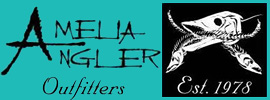St. Mary’s Georgia and Fernandina Beach Florida are sister border towns where trout and red fishing are king. Two historic towns separated by the St. Mary’s River and Sound offer excellent back country fishing where sea trout fishing and red bass fishing is excellent year round. Fernandina Beach Florida fishermen have easy access from the Dee Dee Bartel Memorial Park and public boat ramp located at the northwestern corner of Amelia Island. St. Mary’s Georgia fishermen can launch their fishing boats at the St. Mary’s Park boat ramp which offers easy fishing access to both the St. Mary’s River and Sound. An imaginary border is drawn right down the middle of the St. Mary’s River and Sound where fishing on the Georgia side requires a Georgia saltwater license. Fishing on the Florida side requires a Florida saltwater fishing license. However there are more borders that fishermen need to be aware of. One of Captain Tommy Weaver’s more colorful river fishing trips included Joseph Morrison and niece, Lauren Phillips.
“I anchored my boat in a creek that fed the St. Mary’s River where further up the trout and redfish creek, a government signed posted off limits,” Tommy Weaver said. “I needed to get a little closer to that oyster bar for my niece Lauren Phillips to make a good cast, which I eventually anchored our boat just on the other side of the government sign. Lauren made a perfect cast and hooked a 34-inch redfish that gobbled up her live shrimp. About the same time, a Navy patrol boat came into the creek and said that we were under arrest.” I replied, “Not until my niece lands her big redfish!” The officers smiled, allowed Lauren to catch her big red and then made the arrest. The St. Mary’s fishermen were cleared and then returned to the St. Mary’s River, but not to the government posted trout and redfish hole!
For several trout fishing seasons now, the entire area where Kings Bay Navy Base encompasses is posted off limits. While you might venture up a nearby creek only to find posted off limit signs. “Sea trout school in deep holes along the St. Mary’s waterfront and anywhere along the river where there is a steep bank, rocks, or oysters,” Tommy Weaver said. “Most trout fishermen drift a live shrimp deep under an 8-inch trout float.”
The best tide for catching sea trout in the St. Mary’s River Weaver concludes, is the last few hours of the in-coming tide. And while Weaver recommends drifting live shrimp under a trout float for sea trout, he also recommends casting a ¼ ounce led head jig rigged with an “Electric Chicken”, or “Chartreuse” color minnow type plastic tail for stripers, trout and redfish. “Once you find the sea trout in the St. Mary’s River, you are more than likely to find stripers too,” Weaver said. “I recommend casting a jig and plastic tail for the stripers, trolling with buck tail jigs and minnow type lures is also productive as well.” Tommy Weaver once caught a 34-inch sea trout from the St. Mary’s River.
On the Florida side of the St. Mary’s River and Sound, Jolly River harbors both redfish and sea trout during the last of the incoming tide. As you enter Jolly River, the north side of the river has numerous small feeder creeks and shallow oyster flats that offer excellent red and trout fishing. Here inshore fishermen will simply use their electric motor while scouting the shoreline with surface plugs, or “Popping” floats rigged with a live shrimp, DOA shrimp, or Berkley Gulp shrimp. The depth of the bait should be set at on foot and retrieved with a loud “Shrimp” popping sound.
Jolly River eventually feeds the “Chester Flats” where both redfish and sea trout can be found schooling over shallow oyster flats. Look for sea trout to school during the in-coming tide and redfish to school after the tide has been running out for a few hours. “Tiger Basin” is located at the southern mouth of the St. Mary’s River where flood tide red and trout fishing is excellent while working surface plugs over flooded oyster flats. A chrome chug bug with a blue back has accounted for many trophy size reds and trout from these fertile waters where schooling mullet, glass minnows and shrimp are key.
During the summer fishing season, tarpon hold at the mouth of Jolly River and can be seen crashing schools of menhaden and mullet. Summer tarpon fishing is also excellent at the tips of both the St. Mary’s north and south jetty rocks. Tarpon weighing to 150-pounds are often caught and released while fishing dead on the bottom with live mullet, menhaden, or whiting. Cut baits and blue crab are also both excellent St. Mary’s tarpon baits. Fishing on the bottom also produces bull reds, cobia, black drum and a wide variety of sharks. The sea trout season is closed during the month of February on the Florida side of the St. Mary’s river and Sound.
Current Georgia saltwater bag limit for sea trout is 15 trout per day, measuring at least 13-inches in length. Fishermen can keep five redfish per day measuring at least 14-inches in length and not over 23-inches. Fishermen can keep two stripers per day that must measure at least 22-inches in overall length. Fishermen over the age of sixteen will need a Florida saltwater fishing license when fishing on the Florida side of the St. Mary’s River. Saltwater fishermen over the age of 16 will need a Georgia saltwater fishing license when fishing on the Georgia side of the St. Mary’s River.
More information on Georgia saltwater fishing can be found at the Georgia Department of Nature Resources. For Florida saltwater fishing regulations, visit Florida Fish and Wildlife Conservation Commission.










